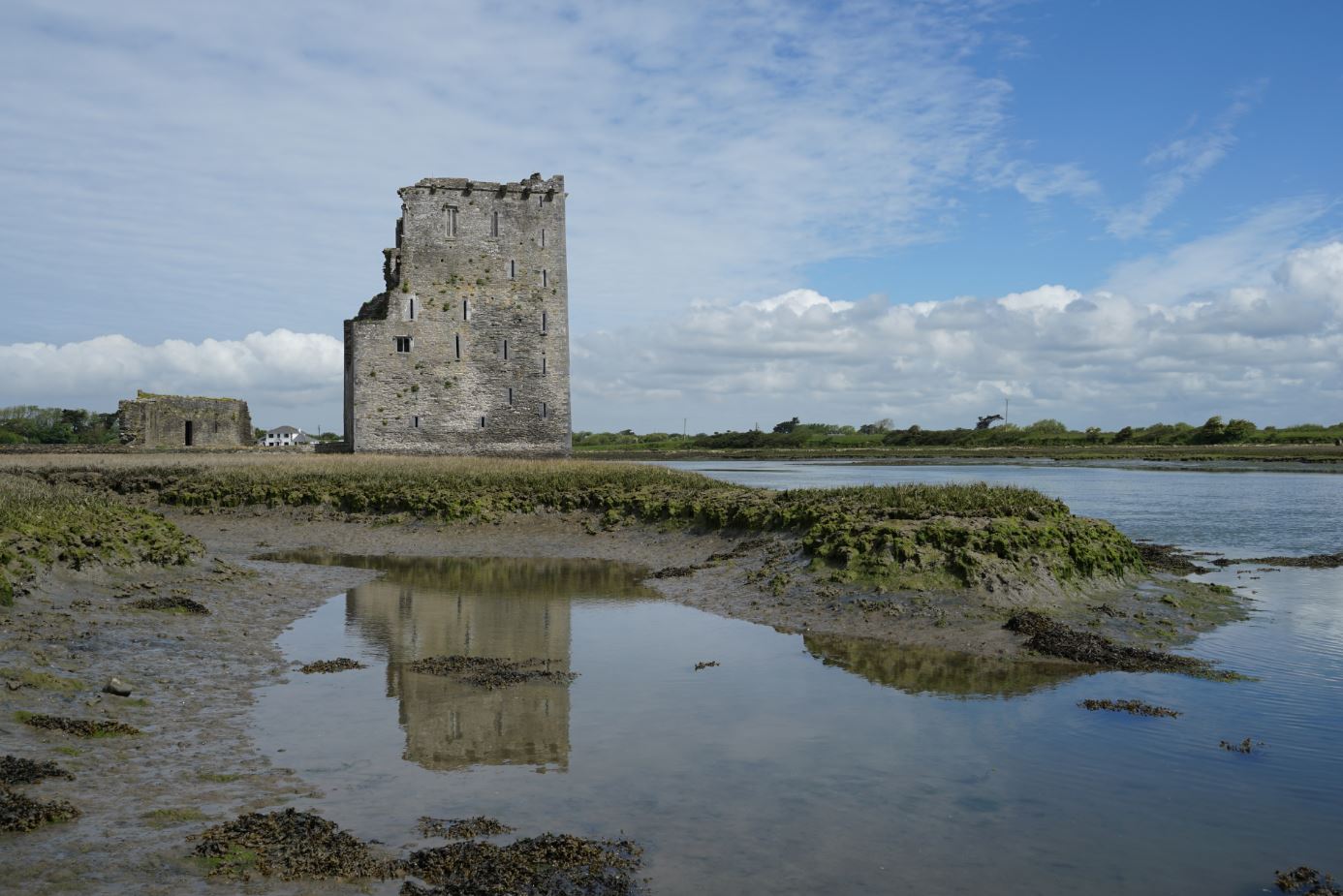1579 - the Desmond Rebellion
On 1st October, 1574, Gerald fitzGerald, 15th earl of Desmond, was pardoned by queen Elizabeth. Despite the revolt of his cousin, James fitzMaurice fitzGerald, as well as his own escape from house arrest in Dublin nearly a year earlier, the earl of Desmond had not only survived with his life, but he had even succeeded in laying the ground for a fresh start to reassert the family’s position in Munster. The timing was important. In 1575, Sir Henry Sidney returned to Ireland as lord deputy. In the summer of 1576, a decade after he had first initiated his scheme for the presidency of Munster, Sidney resurrected his plans to reform the local government of the region. As the new president, he appointed Sir William Drury, an experienced soldier and statesman who had seen service in France and Scotland. Drury immediately toured the region to collect the cess, a tax specifically designed to raise the financial resources to maintain a dedicated army to support the Munster presidency. This was no small tax, and it was partly designed to divert money away from the large land holders who would otherwise have used it to support their private armies. At the same time, the presence of a government army in the region undermined the arguments of the large land holders that they needed their own private armies to defend their estates.
In 1577, president Drury began to implement compositions throughout Munster. The term composition was used to describe the setting down (composing) of fixed rents that the large land holders would pay to the crown. The local lords in Cork, such as the Anglo-Irish Barrys and Roches, as well as the Gaelic MacCarthy chiefs, including the earl of Clancare, agreed to pay the compositions. However, the earl of Desmond, who held lands throughout the region, refused to cooperate. The introduction of both the cess and the composition now tested the earl’s ability to adapt to the new government reforms as well as his loyalty to queen Elizabeth. In January 1578, a meeting was held in Kilkenny between Gerald fitzGerald, Henry Sidney and William Drury. The meeting succeeded in cooling tensions, and over the next few months the earl actively engaged in negotiations to implement the reforms. However, before a final agreement could be made between the two sides, an event occurred that changed everything.
In March 1575, James fitzMaurice fitzGerald, who had not been executed for his leadership of the rebellion in Munster between 1569 and 1573, fled to France. The earl did not stop him from leaving Ireland. Indeed, his absence from Munster gave the earl space to begin negotiations with the president, William Drury. While in France, fitzMaurice even persuaded the French king, Henry III, to write to queen Elizabeth, and on 7th May 1576 she issued a pardon to fitzMaurice. However, he was buying time and covering his tracks. In 1577, he went to Rome and sought approval from pope Gregory XIII for a Catholic invasion of Ireland. With this, fitzMaurice went to Spain and Portugal to recruit the armed forces he needed.
On 17th July, 1579, James fitzMaurice fitzGerald arrived in Dingle harbour in Kerry with a fleet of ships. The next day he disembarked with a force of sixty Spanish soldiers, carrying the standard of the cross with depictions of Mary and Saint John. Together with a small party of Catholic clergy, they began to fortify Dún an Óir, a small promontory projecting into Smerwick Harbour at the western end of the Dingle peninsula. In his company was Dr Nicholas Sanders, an English Jesuit, who came as a papal representative. FitzMaurice immediately dispatched messengers throughout Ireland seeking support for his latest uprising. The earl of Desmond simply reacted by ordering his own soldiers to surround the fort, but he made no concerted effort to arrest fitzMaurice and his Spanish soldiers.
Only weeks after arriving back on Irish soil, fitzMaurice was killed. However, by now the leadership of the rebellion had been taken in hand by John and James fitzGerald, two brothers of the earl of Desmond. Shortly after the landing at Smerwick in July, Henry Davells, constable of Dungarvan, Co. Waterford, had been dispatched to Kerry to report on the situation at Smerwick Harbour. On August 1st, while lodging at Tralee, John and James fitzGerald broke into the constable’s room and murdered him in his bed. The fact that this had happened while the earl and his men were keeping surveillance on fitzMaurice at Dún an Óir nearby did little to convince the government that he had not conspired with his brothers. Of course, the reliance on the earl of Desmond to post his own soldiers to contain the situation at Smerwick simply highlighted the government’s lack of military resources in Munster. However, the fact that the earl failed to take decisive action to prevent the situation from escalating was seen by many as a sign that he could not be trusted.
On 3rd October, Nicholas Malby, who had been sequestered from Connaught to command the government forces in Munster, despite being outnumbered, successfully defeated the rebels led by the earl’s brother, John, in open battle at Monasternenagh near Croom, Co. Limerick. Immediately afterwards, he marched to Askeaton to demand the submission of the earl of Desmond himself. After Gerald refused, Malby burned the town around the castle and plundered the Franciscan friary, desecrating the tomb of his father James, the 14th earl of Desmond, and the tomb of Gerald’s first wife, Joan fitzGerald, also the mother of Thomas Butler, 10th earl of Ormond, whose death in January 1565 had been the catalyst for the Battle of Affane. Over the previous months, the earl had tried to remain neutral, refusing to be drawn into the rebellion led by his brothers, and refusing to openly support the government army in their attempt to subdue the rebellion. Meanwhile, William Drury, (who had been promoted to lord justice), had taken ill and died, and was replaced by William Pelham, an experienced military man, who gave the earl one more chance to join the government side. Over the previous years, the earl had successfully used negotiations as a carefully disguised stalling tactic to buy more time. On this occasion, however, Pelham gave Gerald a deadline of 8am on 2nd November to present himself. When he failed to appear, Pelham proclaimed the earl a traitor ‘to the sound of trumpet’. Gerald had finally run out of time. Whether he intended to or not, the earl of Desmond was now formally recognised as one of the rebels. Fearful that the walls of his castle at Askeaton were insufficient to keep him safe from the English army, the earl was forced into hiding. That this was the correct decision became clear months later.
Little happened over the winter months that followed, except that the earl met envoys from France and Spain, who informed him that their respective kings had held back sending reinforcements because they had heard the earl was dead. Satisfied that the earl was very much alive, and so too hopes that the rebellion might succeed, they returned home, promising military support as they left. On 29th March, 1580, Sir William Pelham besieged Carrigafoile castle in Kerry, which was in rebel hands. After a day of bombardment that breached the castle walls, the defenders, including sixteen Spanish soldiers, were forced to surrender. Except for the Spanish commanding officer, the entire garrison was executed. The effectiveness of the royal artillery during the short siege was a sign of things to come.
Finally, in September 1580 a second papal expedition landed in Dingle with fresh shipments of 500 Spanish and Italian troops, under the command of an Italian colonel, Sebastian da San Guiseppe. The new lord deputy, Arthur Grey, arrived in Kerry and besieged Dún an Óir, still stinging from his embarrassing defeat to James fitzEustace, viscount Baltinglass, and Feagh McHugh O’Byrne in the Battle of Glenmalure
during the summer. His land army was assisted by royal ships in Smerwick Harbour, under the command of Admiral William Winter. After three days bombardment by the government army and navy, the would-be invaders surrendered. Virtually everyone who had defended the fort, or had sought refuge within it, was executed. That was the end of any foreign involvement in the revolt, but the Desmond Rebellion was not extinguished.
Since the defeat at Monasternenagh at the hands of Nicholas Malby, the rebels were reluctant to meet the government forces in open battle. After the fall of Carrigafoile Castle and Dún an Óir in the face of overwhelming artillery bombardment, the rebels were now reluctant to defend fortified positions. Instead, they turned to guerrilla warfare, which prompted the government to establish garrisons throughout Munster during 1580. However, the overall number of crown troops was very small, with the result that they were spread too thinly across the region and in several cases they were easily overwhelmed by the rebels. The rebels also began to attack the towns, such as Youghal, Co. Cork. On 15th November 1579, shortly after the earl of Desmond had been proclaimed a rebel, his soldiers breached the town walls, rampaged through the town, killing many of the inhabitants, including the mayor, and in a symbolic act of defiance they destroyed the queen’s coat of arms above the courthouse. However, such rebel attacks were frequently motivated by a need to sustain the rebel army in food and money, and also were designed to intimidate the townspeople. In the end, they had the opposite effect and forced the towns across the region to look to the crown forces to protect them. Even in Dingle, within the heartlands of the earl of Desmond, the townspeople opted to defend themselves, often inflicting casualties on the rebel attackers. More importantly, however, many of the leading families in the region, including several powerful Gaelic ones, had refused to support the earl.
In 1583, Thomas Butler, earl of Ormond, was appointed commander of the English forces in Munster. He focused on wearing down the rebels, so that by the end of the year the earl of Desmond was constantly on the run, with a small force of some twenty men. In November 1583, after four years on the run, he was finally tracked down. Desperate for food, his men gave away their presence as they stole some cattle and horses near Tralee. Crown soldiers and Gaelic kerne garrisoned at Castlemaine tracked him down to a cabin near Glenageenty. The earl was injured during his arrest, and to ensure that he wouldn’t be rescued by his followers, one of the kerne, Daniel O’Kelly, decapitated the earl. His head was presented to the earl of Ormond at Cork, and later sent to queen Elizabeth and exhibited on London Bridge on 13th December 1583. The most recent rebellion had forced the English government to re-evaluate their failed attempts to reform the local government of Munster. The death of the earl of Desmond now presented the government with an opportunity to embark on a new policy for the region, one that had been tried and tested in Leinster, a full-scale plantation of English settlers across Munster.



